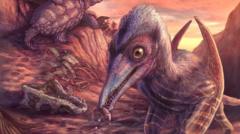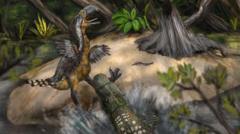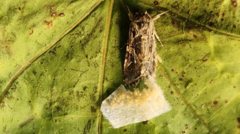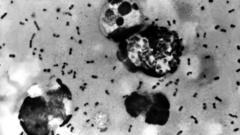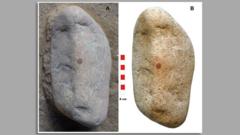In a remarkable revelation, scientists have identified a new species of pterosaur that once soared over Earth more than 200 million years ago. Named Eotephradactylus mcintireae, translating to "ash-winged dawn goddess," this ancient creature's jawbone was originally unearthed in Arizona in 2011. Recent advancements in scanning technology have confirmed it as a previously unknown species, a finding presented in the journal Proceedings of the National Academy of Sciences.
The research, spearheaded by experts at the Smithsonian's National Museum of Natural History in Washington DC, indicates that this seagull-sized pterosaur lived approximately 209 million years ago, marking it as the oldest pterosaur discovered in North America. "The bones of Triassic pterosaurs are small, thin, and often hollow, leading to their destruction before fossilization," explained Dr. Ben Kligman, emphasizing the rarity of such finds.
The jawbone was preserved in rocks from an ancient riverbed within the Petrified Forest National Park, once part of the supercontinent Pangaea. This fossil-rich site, previously a river, has entombed remnants of Triassic life—including bones, fish scales, and coprolites—illustrating a diverse prehistoric ecosystem.
An analysis of the pterosaur's teeth suggests its diet likely included primitive fish encased in armor-like bony scales, as evidenced by noticeable wear at the tips. "Our identification of pterosaur fossils in these ancient deposits hints at the possibility of other similar fossil sites around the world," Dr. Kligman stated.
This discovery provides a glimpse into an evolutionary transition that occurred 200 million years ago, capturing a scene where extinct animals like giant amphibians coexisted with ancestors of modern species, such as frogs and turtles. The evidence unearthed in this fossil bed helps scientists understand the dynamic interplay of species during the Triassic period.
The research, spearheaded by experts at the Smithsonian's National Museum of Natural History in Washington DC, indicates that this seagull-sized pterosaur lived approximately 209 million years ago, marking it as the oldest pterosaur discovered in North America. "The bones of Triassic pterosaurs are small, thin, and often hollow, leading to their destruction before fossilization," explained Dr. Ben Kligman, emphasizing the rarity of such finds.
The jawbone was preserved in rocks from an ancient riverbed within the Petrified Forest National Park, once part of the supercontinent Pangaea. This fossil-rich site, previously a river, has entombed remnants of Triassic life—including bones, fish scales, and coprolites—illustrating a diverse prehistoric ecosystem.
An analysis of the pterosaur's teeth suggests its diet likely included primitive fish encased in armor-like bony scales, as evidenced by noticeable wear at the tips. "Our identification of pterosaur fossils in these ancient deposits hints at the possibility of other similar fossil sites around the world," Dr. Kligman stated.
This discovery provides a glimpse into an evolutionary transition that occurred 200 million years ago, capturing a scene where extinct animals like giant amphibians coexisted with ancestors of modern species, such as frogs and turtles. The evidence unearthed in this fossil bed helps scientists understand the dynamic interplay of species during the Triassic period.

